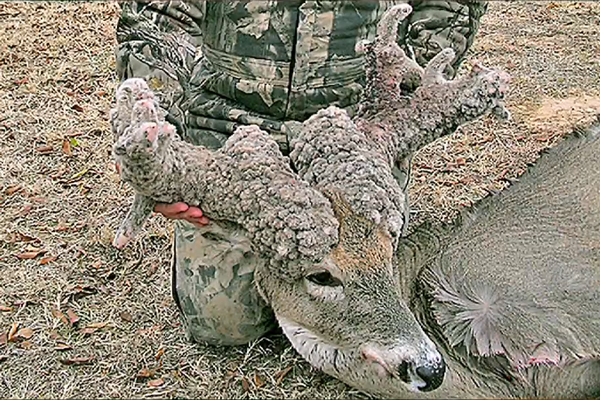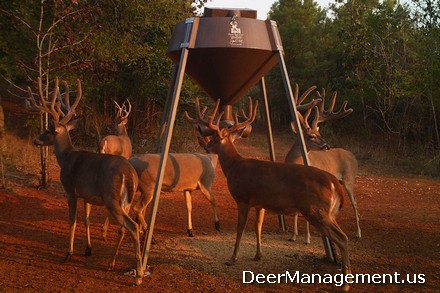Stag bucks can result from the condition hypogonadism. Hypogonadism is fairly common in parts of Central Texas. Hypogonadism stag bucks keep antlers in velvet year-round and are sterile.
What is Hypogonadism in Deer?
White-tailed bucks afflicted with hypogonadism are somewhat common in parts of the Texas Hill County. The majority of these stag bucks come from the “granite gravel” soil. This soil type dominates much of Llano County and Mason County. This type of soil also extends slightly into counties bordering to the north and south.
In normal years, the incidence of stag bucks in the Edwards Plateau region is low, with 5-10 percent of bucks having hypogonadism. During years of increased hypogonadism, incidence in granite gravel areas can rise 50 to 80%. In certain years, some areas reported over 40 percent of bucks killed were stag bucks.

Hypogonadism in Deer in Central Texas
The cause of hypogonadism in deer is unknown, but research suggests that the condition seems related to post-drought conditions. Researchers believe it must be caused by consumption of some plant containing a gonadotoxin that proliferates in granite gravel soils following drought.
Unfortunately, such a plant was never identified in the Texas Hill Country by researchers. Generally speaking, veterinarians believe that consumption of certain plants associated with the breaking of drought causes increased deer health problems.
For example, Sitka black-tailed deer on Kodiak Island in Alaska exhibit a high rate of hypogonadism, abnormal antler growth, and odd antler shedding. Researchers hypothesize that it may be the result of long-term consumption of plants high in estrogen.
In the granite gravel area of the Edwards Plateau, it is theorized that pregnant females consuming these phytoestrogens pass these substances to male fetuses via placenta causing hypogonadism before birth. Furthermore, it’s suggested that whitetail bucks can contract the condition later in life if their own diet is high in phytoestrogens.
Plants Cause Hypogonadism?
The theory is that bucks be impacted prior to or after birth. If while in the womb, hypogonadism is caused by plants that pregnant does are consuming during gestation. Two plants in the region can become abnormally high in natural plant estrogens have been mentioned as possible causes of hypogonadism in bucks.
Unfortunately, there is no evidence to support the claim. That said, the two plants identified seem to make sense based on their characteristics. Spikemoss is a low, mat-forming plant related to ferns that grows in granite outcrops. It’s the first plant to “green up” following prolonged drought. As a result, spikemoss may be eaten by gestating does in abnormally high amounts in late-winter and early-spring.
In addition, peavine is an annual weed that is common in wet springs in the granite gravel area of the Hill County. It’s especially prolific following drought when there is a lot of bare ground. It’s been noted by veterinarians that abnormally high levels of selenium in deer diets can cause pen-raised bucks to not shed their antlers. Peavine is known to contain high levels of selenium, so it may contribute to hypogonadism in bucks.
Managing Hypogonadism in Deer
There seems to be no easy answer to hypogonadism when it comes to white-tailed deer management. Though two plants have been hypothesized to cause the condition in deer, it turns out that many plants can be high in estrogen. As a result, there may be no way to manage the habitat or deer population to improve the situation.
It is interesting that hypogonadism is most common in the granite gravel area of Central Texas. There is definitely something in the soil, or so it seems. It is possible that there may be some synergistic effects of plant toxins, compounds, or estrogens combined with high levels of some trace minerals in these soils. The cause remains a mystery, but hypogonadism has an impact on deer management in this area. Stag bucks remain in velvet year-round and are sterile, so they use habitat and provide little in return.

